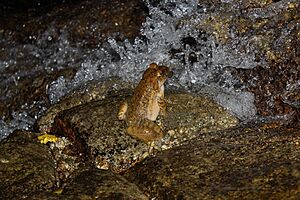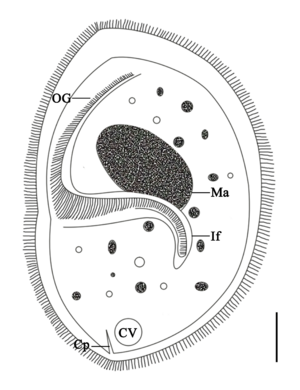Quasipaa spinosa facts for kids
Quick facts for kids Quasipaa spinosa |
|
|---|---|
 |
|
| Conservation status | |
| Scientific classification | |
| Synonyms | |
|
Rana latrans David, 1872 |
The Quasipaa spinosa is a type of frog that belongs to the family Dicroglossidae. It has many common names, like the Chinese spiny frog or giant spiny frog. People also call it the Chinese edible frog and spiny paa frog.
These names come from how the frog looks. It is quite large for a frog, and the male frogs have a spiny chest. This frog can grow to be over 10 centimeters long. This makes it the biggest frog found in Hong Kong.
Contents
About the Quasipaa Spinosa Frog
Scientists study how different animals are related. They have looked closely at the Quasipaa spinosa frog. They think it might actually be three different types of frogs that look very similar. These different groups live in different parts of China.
One group lives in Yunnan. Another group is found in southeastern China, in places like Anhui and Zhejiang. The third group lives in south-central China, in areas like Hunan and Guangdong. There is also a frog called Quasipaa exilispinosa that seems to be closely related to these groups. Its closest relative is the Quasipaa acanthophora from Vietnam.
Where the Quasipaa Spinosa Lives
You can find the Quasipaa spinosa frog in China, mainly south of the Yangtze River. This includes Hong Kong. Scientists also think it might live in Vietnam, Laos, and Myanmar. However, it is sometimes confused with other similar frogs in those areas.
This frog likes to live near rocky streams. You can find it in evergreen forests and open areas on hills and mountains. It lives at heights of about 200 to 1500 meters above sea level.
Description and Life Cycle
The most special thing about the Quasipaa spinosa is the spiny skin on the chest of the male frogs. These spines are made of a tough material called keratin. The frog is usually dark brown with yellowish spots.
These frogs are medium to large in size. Male frogs usually grow to about 80 millimeters long. Females can be 82 millimeters or longer, sometimes up to 128 millimeters. As mentioned, it is the largest frog in Hong Kong. Some studies show that males are often bigger than females. The size of the frogs can depend on the temperature and how much rain there is. Male frogs can weigh at least 133 grams.
The Quasipaa spinosa breeds in streams. They lay their eggs in the water, often under stones. They usually breed from April to October. Male frogs make calls near slow-moving parts of streams or pools. Their call has three to seven notes, with the last note being the longest.
Scientists have studied these frogs in Tai Mo Shan Country Park in Hong Kong. They found that these frogs tend to stay in the same area. There are not many frogs in these areas, usually about 13 to 42 frogs per 100 meters of stream. Also, there are more female frogs than male frogs.
How People Use This Frog
The Quasipaa spinosa frog is used as food and medicine in China. Many people think it is a special dish. Because of this, many of these frogs are caught from the wild. This has caused their numbers to drop a lot.
In Jiangxi province alone, the amount of Quasipaa spinosa sold for food is huge. It is as much as all the frog meat traded around the world. People also try to farm these frogs. However, these farms often get young frogs or tadpoles from the wild. This means farming might not help wild populations as much as people hope.
Protecting the Quasipaa Spinosa
The number of Quasipaa spinosa frogs has gone down a lot. Because of this, the International Union for Conservation of Nature has listed it as a "Vulnerable" animal. This means its population has dropped by more than 30% in the last three generations.
The main reasons for this decline are people catching too many of them for food. They are also losing their homes because of farming and the building of dams. Even a small amount of catching can make it much harder for small groups of these frogs to survive.
The Quasipaa spinosa is not a specially protected animal in China, except in protected areas. This means there are not many rules to protect it. However, in Fujian, it is now against the rules to sell wild Quasipaa spinosa. Farmed frogs need to have a special certificate. It is not yet known if these rules are being followed well. But they could help the wild frog populations.
Parasites
Like many animals, the Quasipaa spinosa can have tiny living things called parasites. One type of parasite found in this frog is called Sicuophora multigranularis.




